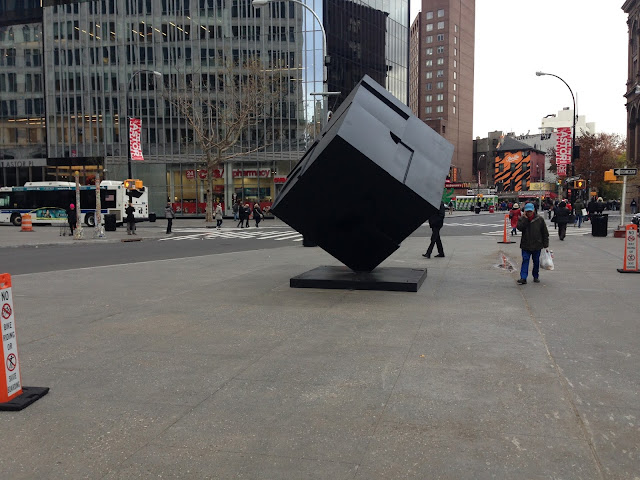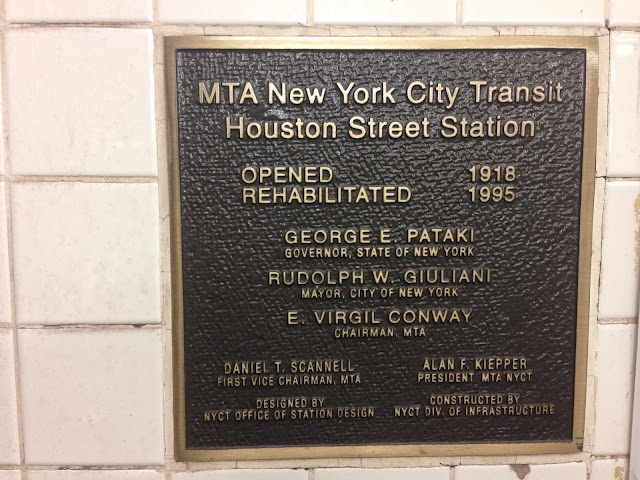Astor Place recently underwent some renovations that created a new pedestrian area to replace one of the streets. Tables and chairs have been set up where metal auto monsters once roamed.
Even more exciting is the reappearance of the big cube sculpture in the same pedestrian area.
The Cube has been an iconic presence in downtown Manhattan and Astor Place didn't feel right without it. I actually didn't know whether it would ever be returned or if The Powers That Be had decided that it had somehow run its course. But I'm glad it's back and I no long have a lost-at-sea feeling while walking through the area.
Amazingly I never knew that the Cube is actually called Alamo. It is from 1967 and by Bernard (Tony) Rosenthal.
I've always liked that it is an interactive piece of art because it can be spun by any person or persons who have the strength and panache to just go for it.
When I first visited on November 9 (let history note that it was a cold and rainy day) there was a sign next to Alamo reassuring people that after a little more renovation, the barricades around it would be removed and the spinning could commence.
However, I saw a guy grab one of the corners and try to give it a spin, but the Cube wouldn't budge. It seemed to be welded in place to its base support. Maybe that will change eventually but it was disappointing to see.
If a big cube doesn't do it for you, there is other cool art at Astor Place that has also been restored.
I have covered some of Jim Power's mosaic work in previous posts on the East Village and here at Astor Place there are four more light posts that have the Mosaic Man's quirky, colorful, wonderful work on them, along with a big flower pot.
These
particular mosaics include tributes to the NYPD and FDNY and a big American
flag. There are also tributes to many local shops and sites including the
now-gone CBGB's and Billy's Antiques and Props, which unfortunately is
also gone. It had to close its distinct tent location at East Houston
Street in 2012 to make way for construction of a rather generic retail
brick building. At least the Bowery Mural on the same block keeps that area interesting.
The removed street was a section of the actual street that is called Astor Place and which ran west to east from Broadway to East 8th Street near St. Marks Place. With the new pedestrian area, there are now two strips of Astor Place on either side of the plaza but the middle part is gone.
After the new renovation plans for the area were revealed by the city, the Greenwich Village Society for Historic Preservation (GVSHP) pointed out that Astor Place followed an old Native American trail that appeared on maps going back to 1639 and thus represented an important connection between New York City and its native and early Dutch roots.
Centuries ago the Lenape lived in this area of the country and what is now Astor Place was a meeting spot for three different groups of the Lenape: Canarsie, Sapohannikan, and Manhattan. The trail actually ran east from this meeting spot, connecting to what is now Stuyvesant Street and going all the way to modern-day Second Avenue.
GVSHP petitioned the city to include the area's history in the new designs for Astor Place and apparently they were successful because there are a couple of distinct and marked lines in the ground running across the plaza where the middle section of the Astor Place street used to be.
One reads "Native American Trail 1639" and another says "Astor Place 1836." Just east of the plaza there is another one marked "Stuyvesant Street 1651." Ideally there would even be a plaque or two to provide a bit more info on these topics, but anyone who is interested can always do a Google search.
Down in the station there are many plaques with beavers on them, which I admit I had never noticed before. Even if I had noticed them, I would have just been confused at their seeming randomness.
There is, however, a good reason for the beaver plaques because John Jacob Astor (as in 'Astor Place') amassed his fortune by trading beaver pelts with the Lenape. The beaver plaques and Astor Place name tablets in the station are all beautiful and multi-colored and date back to the station's original 1904 opening.
One final item of note: a building on the western side of Astor Place with a Starbucks on the ground floor seems innocent enough (unless you hate Starbucks) but it is actually the former site of the Astor Opera House, which also sounds innocent except that is was where a major riot occurred in 1849 that killed approximately 25 people and wounded over 120.
It started in a way that we don't think of most riots starting: over a dispute between two theater actors over who could perform Shakespeare better.
There was some more social context to it, of course. This was a time in New York with a lot of tensions between social classes, including nativists versus Irish immigrants and both of those groups against the wealthy elite. Fortunately there are no longer class issues in America having to do with nativism and elitism...
Anyway in the case of the riot, the working classes and Irish immigrants revolted against the upper classes and the British culture that the elite embraced and came to represent.
One of the actors was a celebrated British performer named William Charles Macready and his rival was Edwin Forrest, who was the first major American actor and was passionately embraced by the working classes and Irish immigrants.
Tensions had been bubbling for years and even decades, with British actors being targets of American anger going back to the 1700's because they were a tangible way for anti-British sentiments to be expressed.
The Astor Opera House itself caused anger and resentments to come to a head because wealthy theater lovers had it built for the upper classes as a way of being separate from the working classes. Traditionally everyone had mixed in when attending the theater and so this new opera house for the wealthy was an outrage to the populists.
(Depiction of the Astor Opera House in 1850)

The riot occurred on May 10, 1849, when thousands of angry people gathered outside the Astor Opera House where the British actor Macready was to perform Macbeth. The crowds had skirmishes with the police as they threw stones at the building and tried unsuccessfully to set the building on fire.
There was such chaos inside the theater that the play had to be finished in pantomime, followed by Macready sneaking out in a disguise.
The state militia was called upon to deal with the crowds outside the building. After the troops issued warnings that were not heard, they fired into the air and then directly into the crowds, which was the first time a state militia had ever done that. Most of those killed were from the working classes, and many were innocent bystanders. This act by the militia outraged the working classes and was praised by the elite of the city.
Astor Opera House came to be known by some as the 'Massacre Opera House' at 'DisAster Place' and it did not survive much longer as a theater. The wealthy would build a new opera house, the Academy of Music, which was located a little more uptown and thus further away from the downtown lower classes. The current building on that spot has condominiums and the aforementioned Starbucks and was built in 1890.
After learning of the Astor Place Riot it was a bit odd and eerie to walk around in the area that I have walked through so many times without knowing that part of its history. Compared to the deadly riot it now seems like such a tranquil place. I will certainly think twice the next time I'm tempted to complain of how 'busy' or 'chaotic' the intersection is.


































































